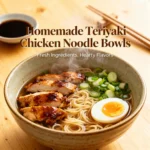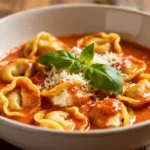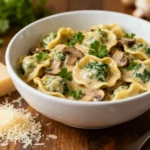Teriyaki Chicken Noodle Bowls: A Flavor-Packed Fusion of Japanese-Inspired Comfort
If you’re craving a meal that’s both satisfying and full of vibrant Asian flavors, look no further than Teriyaki Chicken Noodle Bowls. This dish blends the savory-sweet essence of classic teriyaki sauce with tender grilled chicken, fresh vegetables, and your choice of noodles—making it a go-to favorite for weeknight dinners, meal prep, or entertaining guests. Whether you’re cooking at home or looking to elevate your takeout game, this recipe offers endless versatility, bold taste, and an irresistible aroma that fills your kitchen with warmth.
The History of Teriyaki and Its Culinary Evolution
The word “teriyaki” comes from the Japanese words teri, meaning luster or shine (referring to the glossy finish), and yaki, which means grilled or broiled. Originally developed in Japan during the 17th century, teriyaki was a method of cooking fish or meat by grilling or broiling it with a glaze made from soy sauce, mirin (sweet rice wine), and sugar. Over time, this technique became widely popular across Japan and eventually found its way into global cuisine, especially in North America.
In the United States, teriyaki evolved beyond its traditional roots, often incorporating ingredients like garlic, ginger, and honey to suit Western palates. It became synonymous with quick, flavorful meals served in Japanese-American restaurants and fast-casual eateries. The teriyaki chicken bowl emerged as a modern fusion dish—combining Japanese-inspired proteins with American-style portioning, convenience, and presentation. Today’s version frequently includes steamed rice or noodles, crisp vegetables, and a thick, syrupy sauce that coats every bite.
Ingredients Breakdown: What Makes This Dish Shine
The magic of Teriyaki Chicken Noodle Bowls lies in its balance of sweet, salty, umami, and aromatic elements. Let’s break down each component:
- Chicken Breast or Thighs: Boneless, skinless chicken breasts are lean and absorb flavor well, while thighs offer richer taste and juiciness due to their higher fat content.
- Soy Sauce: Provides the foundational saltiness and umami depth. Use low-sodium soy sauce if you want more control over salt levels.
- Mirin: A sweet rice wine essential for authentic teriyaki flavor. If unavailable, substitute with dry sherry or a mix of rice vinegar and sugar.
- Brown Sugar or Honey: Adds sweetness and helps create the signature sticky glaze when reduced.
- Fresh Ginger and Garlic: These aromatics infuse the sauce with warmth and complexity, elevating the overall profile.
- Sesame Oil: Used sparingly for finishing, it adds a nutty fragrance that enhances the dish without overpowering it.
- Noodles: Options include soba, udon, ramen, rice noodles, or even whole wheat spaghetti. Each brings a different texture and mouthfeel.
- Veggies: Bell peppers, broccoli, carrots, snap peas, mushrooms, and green onions add color, crunch, and nutrition.
- Cornstarch: Helps thicken the sauce into a luxurious glaze that clings beautifully to the chicken and noodles.
- Toasted Sesame Seeds and Green Onions: For garnish—adds visual appeal and subtle crunch.
Step-by-Step Recipe: How to Make Teriyaki Chicken Noodle Bowls at Home
Ingredients:
For the Teriyaki Sauce:
- ½ cup soy sauce (low-sodium preferred)
- ¼ cup mirin
- ¼ cup brown sugar (packed)
- 2 tablespoons honey
- 2 cloves garlic, minced
- 1 tablespoon fresh ginger, grated
- 1 teaspoon cornstarch
- 2 tablespoons water
For the Chicken:
- 1 pound boneless, skinless chicken breasts or thighs, thinly sliced
- 1 tablespoon vegetable oil
- Salt and pepper to taste
For the Bowl Assembly:
- 8 oz noodles of choice (udon, soba, ramen, etc.)
- 2 cups broccoli florets
- 1 bell pepper, julienned
- 1 medium carrot, julienned or shredded
- ½ cup snap peas
- 2 green onions, sliced
- 1 tablespoon sesame seeds (toasted)
- 1 teaspoon toasted sesame oil
- Optional: soft-boiled egg, kimchi, avocado slices
Directions:
- Prepare the Teriyaki Sauce: In a small saucepan, combine soy sauce, mirin, brown sugar, honey, minced garlic, and grated ginger. Whisk together over medium heat until the sugar dissolves. In a separate bowl, mix cornstarch with water to make a slurry. Add the slurry to the sauce and continue whisking gently for 3–5 minutes until the sauce thickens slightly and turns glossy. Remove from heat and set aside.
- Cook the Noodles: Bring a large pot of salted water to a boil. Cook your chosen noodles according to package instructions until al dente. Drain and rinse under cold water to stop the cooking process. Toss with a drizzle of sesame oil to prevent sticking. Set aside.
- Blanch the Vegetables: While the noodles cook, bring another pot of water to a boil. Add broccoli and blanch for 2 minutes. Follow with bell peppers, carrots, and snap peas; cook for another 1–2 minutes until bright and tender-crisp. Immediately transfer to an ice bath or run under cold water to preserve color and texture. Drain well.
- Cook the Chicken: Heat vegetable oil in a large skillet or wok over medium-high heat. Season chicken slices with salt and pepper. Add to the hot pan in a single layer and sear for 3–4 minutes per side, or until golden brown and cooked through (internal temperature should reach 165°F). Remove chicken from the pan and let rest briefly before slicing into strips.
- Glaze the Chicken: Return the cooked chicken to the skillet. Pour about half of the prepared teriyaki sauce over the chicken and simmer for 1–2 minutes, stirring occasionally, allowing the chicken to soak up the flavors and get coated evenly.
- Assemble the Bowls: Divide the cooled noodles among serving bowls. Arrange the blanched vegetables neatly around the edges. Place the glazed chicken in the center. Drizzle additional warm teriyaki sauce over the top for extra flavor.
- Garnish and Serve: Sprinkle with sliced green onions and toasted sesame seeds. Add optional toppings like a soft-boiled egg, avocado, or a spoonful of kimchi for tang. Finish with a few drops of toasted sesame oil for aroma. Serve immediately while warm.
Tips for Perfect Teriyaki Chicken Noodle Bowls Every Time
- Don’t Overcook the Chicken: Slicing it thinly ensures quick, even cooking. Overcooking leads to dryness, so remove it from heat just as it turns opaque.
- Balance the Sauce: Taste your teriyaki sauce before adding it to the chicken. Adjust sweetness with honey, saltiness with soy sauce, or acidity with a splash of rice vinegar.
- Make Ahead the Sauce: Teriyaki sauce can be made up to one week in advance and stored in an airtight container in the refrigerator. Reheat gently before use.
- Use Fresh Aromatics: Fresh ginger and garlic make a huge difference compared to powdered versions. Grate them finely for maximum infusion.
- Customize Your Veggies: Feel free to swap in zucchini, bok choy, cabbage, or edamame based on availability and preference.
- Double the Batch: This recipe is ideal for meal prepping. Store components separately in airtight containers for up to 4 days in the fridge.
- High Heat for Caramelization: When searing the chicken, ensure your pan is hot enough to get a nice crust, which enhances flavor via the Maillard reaction.
Variations and Customizations: Make It Your Own
One of the greatest strengths of Teriyaki Chicken Noodle Bowls is their adaptability. Here are some creative twists:
- Pineapple Teriyaki: Add diced fresh pineapple to the sauce or serve it on top for a tropical twist. Pineapple also contains bromelain, which naturally tenderizes meat.
- Spicy Kick: Stir in sriracha, chili garlic sauce, or red pepper flakes into the teriyaki sauce for heat lovers.
- Vegetarian/Vegan Option: Replace chicken with tofu, tempeh, or seitan. Use maple syrup instead of honey and ensure all other ingredients are plant-based.
- Different Noodles: Try spiralized zucchini (zoodles) or kelp noodles for a low-carb alternative. Ramen noodles add heartiness, while rice noodles keep it gluten-free.
- Korean Fusion: Add gochujang to the sauce and top with pickled radishes and kimchi for a Korean-Japanese hybrid.
- Grill It: Marinate the chicken in teriyaki sauce for 30 minutes, then grill for smoky flavor. Slice and serve over chilled soba noodles.
- Coconut Milk Twist: Simmer the sauce with a splash of coconut milk for a creamy, Thai-inspired variation.
Health Considerations and Nutritional Value
While delicious, traditional teriyaki sauce can be high in sodium and sugar. However, with mindful adjustments, this dish can fit into a balanced diet.
Nutritional Highlights (per serving, approx. 1 bowl):
- Calories: ~450–550 kcal
- Protein: 30–35g (from chicken and optionally eggs/tofu)
- Carbohydrates: 50–60g (mainly from noodles and sauce)
- Fats: 10–15g (mostly unsaturated from sesame oil and healthy cooking oils)
- Sodium: 900–1200mg (can be reduced using low-sodium soy sauce)
- Sugars: 18–22g (largely from brown sugar and mirin; reduce with less sweetener or sugar substitutes)
Ways to Make It Healthier:
- Use tamari or coconut aminos for a gluten-free, lower-sodium alternative to soy sauce.
- Reduce added sugar by cutting back on honey or substituting with monk fruit syrup.
- Increase fiber by adding more non-starchy vegetables like kale, spinach, or Brussels sprouts.
- Choose whole grain or legume-based noodles (like black bean or lentil pasta) for added protein and fiber.
- Limit sauce quantity—serve it on the side to control intake.
- Add fermented foods like kimchi or miso paste for gut health benefits.
This dish provides a good balance of macronutrients and can support muscle repair, energy production, and satiety when portioned appropriately.
Frequently Asked Questions (FAQ)
Q: Can I make teriyaki sauce without mirin?
A: Yes! Substitute mirin with a mixture of 1 tablespoon rice vinegar + 1 tablespoon sugar + 2 tablespoons water. Alternatively, dry sherry or white wine with a pinch of sugar works too.
Q: Is teriyaki chicken healthy?
A: It can be! The healthiness depends on how it’s prepared. Homemade versions allow control over sugar, sodium, and oil. Avoid deep-fried versions and excessive sauce.
Q: Can I freeze teriyaki chicken?
A: Absolutely. Cooked chicken in teriyaki sauce freezes well for up to 3 months. Thaw overnight in the fridge and reheat gently on the stove. Note: Noodles don’t freeze well and may become mushy.
Q: What type of noodles are best?
A: Udon offers chewiness, soba gives an earthy flavor, ramen is rich and springy, and rice noodles are light and gluten-free. Choose based on dietary needs and texture preference.
Q: Can I use store-bought teriyaki sauce?
A: Yes, but many bottled sauces contain preservatives, artificial flavors, and excess sugar/sodium. Always check labels, or enhance store-bought sauce with fresh ginger, garlic, and a squeeze of lime juice.
Q: How do I prevent soggy bowls?
A: Keep components separate until ready to eat, especially if packing for lunch. Pack sauce on the side and assemble just before consuming.
Q: Are there gluten-free options?
A: Yes! Use tamari instead of soy sauce, choose gluten-free noodles (rice, buckwheat soba, or chickpea pasta), and verify all ingredients are certified GF.
Summary
Teriyaki Chicken Noodle Bowls are a harmonious blend of sweet, savory, and umami flavors, featuring tender chicken glazed in a glossy homemade teriyaki sauce, served over noodles with crisp-tender vegetables. Easy to customize, nutritious when balanced, and perfect for busy weeknights or meal prep, this dish brings restaurant-quality satisfaction straight to your kitchen table.










